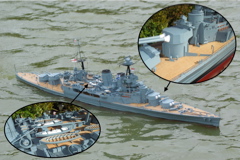
|
|
|
|
HMS Hood, experiences with an Almost Ready to Run Model (David McNair-Taylor).(reprinted from the Autumn 2009, club newsletter) The Original ShipThe Admiral Class ships were developed during the First World War to counter the threat of the German Mackensen classes, but only HMS Hood was completed. The vessel was commissioned in 1920, while her three sister ships were cancelled and broken up. The ship was named after Admiral Samuel Hood, first Viscount Hood (1724 - 1816). The Battle of Jutland had shown that battle cruisers were vulnerable to steeply angled artillery fire, but construction of the Hood continued despite this discouraging experience, even though the idea of developing a completely new design with improved armour was under consideration at the time. In the 1920's the ship became a national monument in Great Britain after gaining world-wide fame by completing a circumnavigation of the globe to visit all corners of the British Empire. On Empire Day, 24th May 1941, the Hood, together with the Prince of Wales, took part in the hunt for the Bismarck (which was accompanied by the Prinz Eugen). The ships met in the Denmark Strait and during this action the ship came under devastating steep-angle fire from the Bismarck and Prinz Eugen, which succeeded in gaining a hit that started a fire on the boat deck , a second hit is believed to have spread fire from the torpedo stowage to the main magazines. The resultant gigantic explosion split the Hood in two, and the wreck sank in just two minutes; there were only three survivors. The Prince of Wales was subsequently forced to break off the fight and turn away after suffering severe damage from artillery. On 26th May the Royal Navy caught and sank the Bismarck with the loss of 2000 members of her crew. The action ended German warship incursions into the Atlantic. The Graupner ARTR ModelAfter pricing up a Fleetscale Semi-Kit and finding it was too big to go in my car and would cost in the region of at least £1600 when completed, I decided to purchase the Graupner ARTR model which is slightly smaller being just under 6ft overall, I made the purchase with a little trepidation I might add! I am a scratch builder and detail freak and exhibit my models with the Surface Warship Association at locations such as the Portsmouth Historic Dockyardi, and the Hood would need to be of an acceptable finish and detail to not appear as a toy. The model has only just become available in the UK and I ordered one from the first batch on the understanding that it could be returned if it was not up to the standard I wanted. I need not have worried, the model is built in China for Graupner and has a first class finish with lots of excellent detail. I had to put better quality hooks on the cranes and ammunition davits. Also, to improve the level of detail, I made a new main boat boom, completed the rigging, had to re-rig and detail the sea boats and davits. I also scratch built and fitted new boat booms, constructed two night man overboard markers and fitted them, remade and rigged the smaller boat booms, made additional fittings for the main mast, and obtained from BECC signal flags and ensigns to show the signals flying at the time of her loss in May 1941. The model also needed 4.5 Kg of lead ballast. You also need to install all the electronics except the motors.
I was supplied with two "Plug and Play" Mtronics 15 amp speed controllers which had several problems: varying neutral positions, little throttle control, and a tendency to run the motors in the opposite direction when they felt like it, I would not recommend these "Plug and Play" versions and have replaced them with programmable Mtronics ones. Power is provided by four Speed 400 Type motors . The motors ran slow on 7.2 volts and a much better performance has been obtained using four 8.4 volt NiMH batteries which give a realistic scale speed ( I have heard of one of these models being run on 12 volts but this must really overload these motors as they are rated at 6 - 8.4 volts only). The model has a very large turning circle and motor power is recommended to aid manoeuvring. In summary, she is an excellent performer on the water and, with relatively few modifications, looks fantastic as a static model. Scale Models like this do not come cheap as the retail price is about £1200 but I paid considerably less via "A Model World". Certainly not a toy but I would say that it is an excellent price for a true scale model of this standard. |

